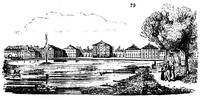329. The palace and gardens of Nymphenburg are situated about four miles from Munich, on a perfectly flat surface, without any distant prospect, the country around being elevated table-land for several miles in every direction. There never was an English garden, the merits of which might be more completely ascertained by the study of the plan (fig. 80.). These gardens were laid out by Louis Sckell, and contain two of the finest jets of water in Germany. These jets are not supplied by elevated fountains, but by the pressure produced, in one case, by a machine driven by water, and in another, by a steam-engine: both are the invention of M. Baader, the chief of the engineers of the mines of Bavaria. The water is forced into powerful air-vessels by pumps, driven by undershot water-wheels; these air-vessels unite in a main which supplies a jet that will send a column of water, about 1. 5 inch in diameter, 130 feet high; or a thin, hollow cylinder of water, nine inches in diameter, eighty feet high. The thickness of the water forming the circumference of the cylinder may be about one-eighth of an inch. Air is drawn in along with the water; and when it escapes by the jet, it makes a loud crackling noise. Several animals were at one time kept in this garden, but at present there are only some beavers. When the natural disadvantages of Nymphenburg, with regard to situation and climate, are considered, it must be allowed to be one of the greatest and the most successful gardening efforts in Germany. The trees, it will be seen from the plan, are beautifully massed and grouped; and at the same time breadth of lawn is preserved, and depth of view maintained. The straight walks on both sides of the central canal are lined with large orange trees in the summer season. As compared with English gardens, however, of the same extent and style, the gardens at Nymphenburg are deficient in evergreens, and in variety of trees and shrubs; but this defect is owing to the climate. As far as art is concerned, the late M. Sckell and his successor have done every thing that modern skill in planting, and in artificially undulating the surface, could suggest. Every part of these gardens is open to the public at all times, and without any distinction. The collection of palms in the stove, in November, 1828, consisted of about seventy species, all large plants, recently procured from Holland. The catalogue of the open garden, published in 1826, by Sterler, contains upwards of 3000 species of herbaceous plants. The architecture of the palace is by no means proportionate to the magnificence of the gardens; but we believe it is more intended as a simple country house than as a splendid regal residence. In the view of the entrance front (fig. 79.), and in the plan (fig. 80.), the multitude of parts into which this palace and its dependent buildings are divided, give the whole more the air of a market-place surrounded by dwellings, than of a palace residence in the country. This impression, however, is counteracted by the trees, the long canal, and the grandeur of the jets d'eau. 1, Aviary and cottage. 2 2 2, Sunk fence, in order to admit of a view beyond the boundary. 3, Garden pavilion. 4, Statues. 5. Covered seat or alcove. 6. Range of hothouses in the botanic garden. 7. Kitchen-garden. 8. Buildings connected with the palace, for different officers, troops, &c 9. Cascade. 10, Straight canal. 11, Jets proceeding from rocks, which throw the water, in columns nearly 6 inches in diameter, upwards of 90 feet high. 12, Centre of the palace 13, Cascade. 14, Straight canal. 15, Small temple. 16, Grecian temple. 17, Garden pavilion, containing pictures, statues, china, &c. 18, Place for beavers. 19, Gamekeeper's cottage. 20, Pheasantry. 21, Engine-house. 22, Bridge and water-wheel. 23, Banqueting-house for the use of the public. 24, Private flower-garden and summer-house. 25, Private flower-garden and open bower. 26. Private garden and entrance to the palace. 27. Quadrangle of buildings for the officers of the court, and their establishments. 28. Small gardens for the officers of the court. 29. Poultry yard, sheds, and keeper's cottage. 30. Shelters for game.

